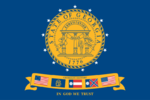Georgia State Flag Referendum (March 2004)
| Georgia State Flag Referendum | |
|---|---|
 | |
| Election date March 2, 2004 | |
| Topic Motto and symbols | |
| Type Advisory question | |
The Georgia State Flag Referendum was on the ballot as an advisory question in Georgia on March 2, 2004. Voters selected the new state flag, which the legislature had adopted in late 2003, in the non-binding election.
The vote was 73.14% for the new state flag and 26.86% for the old state flag, which was adopted in 2001. From 1956 to 2001, the state flag featured part of the Confederate Army battle flag. From 2001 to 2003, the state flag was changed to reduce the battle flag to a single emblem among the state’s other historic flags. The voter-preferred flag features the ‘Stars and Bars’ of the Confederate National Flag, along with the state seal and the phrase ‘In God We Trust.’
Election results
| Georgia State Flag Referendum (March 2004) | ||||
|---|---|---|---|---|
| Result | Votes | Percentage | ||
| 577,320 | 73.14% | |||
| 211,992 | 26.86% | |||
Text of measure
Ballot title
The ballot title was as follows:[1]
Path to the ballot
The Georgia State Legislature passed House Bill 380 (HB 380), which referred the state flag referendum to the ballot.[3] Gov. Sonny Perdue (R) signed the bill and issued an executive order requiring the new state flag to be displayed.[4]
See also
External links
Footnotes
- ↑ NIST, "Georgia Sample Ballot, March 2, 2004," accessed February 26, 2022
- ↑ Note: This text is quoted verbatim from the original source. Any inconsistencies are attributable to the original source.
- ↑ Georgia State Legislature, "House Bill 380," accessed February 26, 2020
- ↑ Georgia Governor, "Executive Order," May 8, 2003
| |||||
State of Georgia Atlanta (capital) | |
|---|---|
| Elections |
What's on my ballot? | Elections in 2025 | How to vote | How to run for office | Ballot measures |
| Government |
Who represents me? | U.S. President | U.S. Congress | Federal courts | State executives | State legislature | State and local courts | Counties | Cities | School districts | Public policy |



